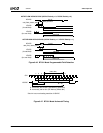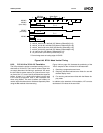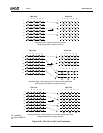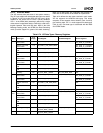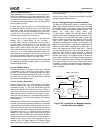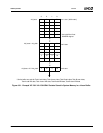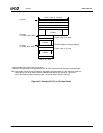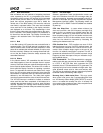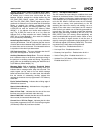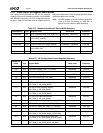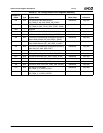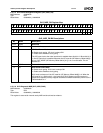
480 AMD Geode™ LX Processors Data Book
Video Input Port
33234H
6.9.11 Bob and Weave
Bob and Weave are two methods of outputting interlaced
video, captured by the VIP, in a progressive scan format.
An example of this is when VIP receives 30 Hz interlaced
(NTSC format) and the data is to be displayed on a TFT
panel that requires progressive scan with a 60-85 Hz
refresh rate. In the Bob method, VIP stores the odd and
even fields in separate buffers. This uses less bandwidth
since each field is line doubled by the display controller,
and displayed as a full frame. The disadvantage is that
there are some observable visual effects due to the reduc-
tion in resolution. In the Weave method, VIP assembles a
full frame from the two fields. The Display Controller then
displays a full resolution frame. This requires more band-
width.
6.9.11.1 Bob
In the Bob method, VIP saves the even and odd fields in
separate buffers. The VIP field interrupt is enabled to indi-
cate to software when a field has been completed. A field
status bit is available that indicates whether an odd or even
field was received. Software can manage these field buff-
ers so that the Display Controller always accesses fully
assembled field data.
6.9.11.2 Weave
In the Weave method, VIP assembles the odd field and
even fields together to form the complete frame in system
memory. Since both fields are rendered simultaneously, the
frame must be double buffered. This allows VIP to render a
frame while the Display Controller is outputting a previous
frame. To assemble the odd and even fields into a single
frame, the VIP must be setup such that the video data odd
base address is separated from the video data even base
address by one horizontal line. The video pitch register
must be programmed with the value of two horizontal lines.
The VIP field interrupt is enabled to indicate to software
when each field has been completed. A field status bit is
available that indicates whether an odd or even field was
received. Software can manage these field/frame buffers
so that the Display Controller always accesses fully assem-
bled frame data.
6.9.12 VIP Interrupts
Software applications need synchronization events and
input error indications from the VIP to manage video dis-
play and processing. Interrupts are generated by the VIP in
the form of Interrupts (INT) and/or Asynchronous System
Management Interrupts (ASMI). The following events can
generate an INT or ASMI. These INTs/ASMIs are disabled
at power-up.
FIFO Line Wrap Error - In cases where minimum line
sizes are input with a low GLIU frequency and high GLIU
latency, there is a potential error condition where the VIP
can receive a third line of video before the first line has
been completely output. VIP can not handle more then two
lines of video in its FIFO. If this condition occurs, the input
video line size should be increased by increasing the
blanking time between each line.
FIFO Overflow Error - FIFO overflows can occur if GLIU
latencies become too long. If a FIFO overflow occurs, the
VIP automatically resets the FIFO. Data in the FIFO is dis-
carded. Video reception begins again at the start of the
next line. No software intervention is required. This INT is
generated to indicate that a FIFO overflow occurred. A high
frequency of these interrupts is likely an indication of sys-
tem bandwidth issues.
FIFO Threshold Hit - The FIFO threshold hit is a program-
mable count that gets compared to the number of WORDs
in a FIFO. If the FIFO data level surpasses the FIFO
threshold, then a FIFO threshold hit INT is generated. The
request priority level is also elevated to its high value. Sep-
arate threshold values exist for video and ancillary data.
This INT may be enabled for debug to determine if potential
bandwidth issues are effecting video capture.
Runaway Line (> 3000 clocks) Error - This error occurs
when a SAV code occurs, but a corresponding EAV does
not. VIP Memory Offset 00h[23] (ERR_DETECT) must be
set to 1 to enable the runaway line error. A runaway line
error causes video reception to stop. Video reception starts
again at the beginning of the next line.



